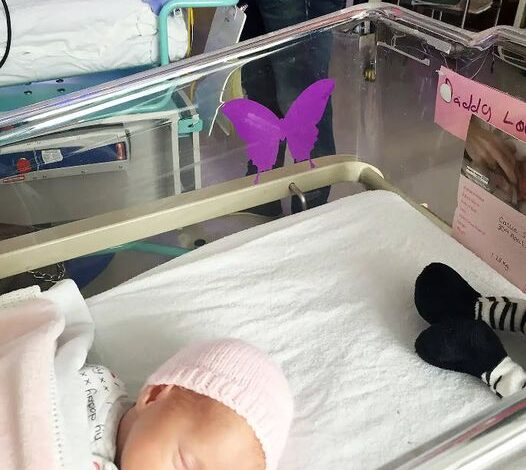
Only weeks after Millie Smith and Lewis Cann learned they were having twin baby girls, they learned that only one would survive.
On April 30, after 30 weeks of a high-risk pregnancy, Smith delivered identical twins, Callie and Skye, the latter who lived only three hours.
Later in neonatal intensive care unit (NICU), Callie slept without her sister in the incubator, with her loving and grieving parents watching over her. In the unit with other babies, an overwhelmed mom of healthy newborn twins innocently told Smith that she was “so lucky” to not have two babies.
Crushed by the words, the new mom couldn’t find the words to explain her loss. Then, she realized that Skye’s legacy was to help other families who lose a child, and it came in the form of a purple butterfly.
In November 2015 Millie Smith and partner Lewis Cann found out they were having their first Child. Smith, who has twins in the family, said she had a “gut feeling” about having a duo and 10 weeks later, doctors confirmed she was expecting identical twin girls.
Less than two weeks after the excitement of knowing they would double the children in their home, the British couple were devastated to learn that one of their babies had a fatal condition and wouldn’t survive after birth.
“During the scan, the doctor didn’t say anything. I was very excited and loved seeing the little babies, but she was silent. Both Lewis and I immediately knew there must be a problem,” Smith said.
Doctors shared the news that one of the babies had anencephaly, which according to the Centers for Disease Control and Prevention (CDC) affects about one in 4,600 babies across the U.S. It’s a serious birth defect where a baby is born without parts of the brain and skull, and “almost all babies born with anencephaly will die shortly after birth.”
Knowing that one baby would die soon after birth, and that there were risks involved for their other baby, the couple decided to move forward with the extremely high-risk pregnancy.
Over the next several months, Smith and Cann named their twins Skye and Callie. “We knew that Skye needed to have a name before she was born,” Smith said. “Knowing she would only survive for seconds or minutes, I wanted her to be named during that time.”
The meaning behind “Skye,” she explained “was somewhere we knew she would always be, that we could look up at the sky and remember our baby.”
When Smith went into labor after only 30 weeks on April 30, she needed an emergency C-section. To help navigate the loss, the couple had a “bereavement midwife” during the birth, and they were put I a special room the called the “Daisy Room,” where families can spend time with a baby before and after she/he passes.
“When the girls were born, they both cried. This was a huge moment, as we were told that Skye would not make a noise or move,” said Smith, who was thankful to have three hours with Skye before she died. “We were cuddling Skye when she passed away. This was the worst moment in our lives. I have never ever felt heartbreak like that before. But I am proud that she fought for so long to spend time with us.”
Born premature, Callie had to stay in NICU while she gained some strength and also in the unit were three other sets of twin.
“Most of the nurses were aware of what had happened, but as time passed, people stopped talking about Skye. After about four weeks, everyone acted as though nothing had happened, meaning the families around me had no idea about our situation,” Smith recalled.
One morning, a stressed mother whose twins were also in NICU, harmlessly said to Smith that she was “so lucky” to not have twins.
“None of the other parents knew what had happened or anything about Skye. The comment was completely innocent and more out of humor…They weren’t to know that I did at one point have two.” Smith continued, “But the comment nearly broke me. I ran out [of] the room in tears and they had no idea why. I didn’t have the heart to tell them what had happened. A simple sticker would have avoided that entire situation.”
It was in that moment Smith realized she had to create something that would speak for parents who had just lost a baby, ensuring the misunderstanding never happens again.
She designed a poster for the NICU explaining both hospital personnel and visitors that any incubator with a purple butterfly on it means that one or more babies, in a set of multiples were lost.
“I chose butterflies, as I felt it was fitting to remember the babies that flew away, the color purple because it is suitable for both boys or girls,” said Smith.
The purple butterfly concept–now under the Skye High Foundation–has spread to hospitals in several countries around the world.
Callie is now a lively, happy seven-year-old, and twin’s memory lives in purple butterfly cards along with other initiatives to help families with babies like Skye all over the world. The purple butterflies now come in numerous forms, like ornaments, cards, blankets, stuffed animals and more.
“Ultimately I will never be able to stop this from happening but the more support groups we can set up and put things in place like the stickers the better it will be. It’s the hardest thing anyone has to deal with,” Smith said.
Dan Haggerty, Who Played Grizzly Adams

In the 1974 film “The Life and Times of Grizzly Adams” and the NBC television series of the same name, Dan Haggerty portrayed a kind mountain man with a lush beard and a bear named Ben. Haggerty passed away on Friday in Burbank, California.
He was seventy-three.

According to his buddy and manager Terry Bomar, the cause was spine cancer.
Mr. Haggerty was employed in Hollywood as an animal trainer and stuntman when a producer asked him to reprise portions of the film’s opening sequences, which were about a woodsman and his bear.
Based on Charles Sellier Jr.’s novel “The Life and Times of Grizzly Adams,” it narrated the tale of a man from California who runs away from the woods after being wrongfully convicted of murder. There, he befriends the local wildlife and tames an abandoned bear.
Mr. Haggerty consented, provided that he may do the full film. After being remade for $165,000, the movie finally brought in close to $30 million from ticket sales. After that, it was made into a television series, and in February 1977, Mr. Haggerty returned to his environmentally conscious duty as the forest’s defender and animal buddy.
John Leonard described the first episode in The New York Times as “lukewarm to the heart.” Mad Jack (Denver Pyle) and the honorable red man Makuma (Don Shanks) bring bread and advise to the man and bear who have taken up residence in a log cabin. Bear washes his fur while the man traps his as they depart the cabin. There’s also a lot of connecting with nature, raccoons, owls, deer, bunnies, hawks, badgers, cougars, and a lump in the throat.
Warm and nostalgic, the show won over fans to Mr. Haggerty, who went on to win the 1978 People’s Choice Award for best new series actor. “Grizzly Adams” gave rise to two sequels: “Legend of the Wild,” which aired in 1978 and was eventually released in theaters in 1981; and “The Capture of Grizzly Adams,” which aired as a TV movie in 1982 and saw Adams being brought back to his hometown by bounty hunters in order to clear his record.
On November 19, 1942, Daniel Francis Haggerty was born in Los Angeles. After his parents divorced when he was three years old, he had a difficult upbringing and repeatedly escaped from military school. Eventually, he moved in with his actor father in Burbank, California.
He wed Diane Rooker at the age of 17. The union broke down in divorce. In 2008, he lost his second wife, Samantha Hilton, in a motorbike accident. His children, Don, Megan, Tracy, Dylan, and Cody, survive him.
In his debut movie, “Muscle Beach Party” (1964), he starred with Frankie Avalon and Annette Funicello as physique builder Biff. Then came came cameos in nature and motorcycle movies, such as “Biker With Bandana” and “Bearded Biker.” In “Easy Rider,” he made a fleeting appearance as a visitor to the hippie commune visited by Dennis Hopper and Peter Fonda.
In reality, Mr. Haggerty kept a variety of wild animals that he had either tamed from birth or rescued from harm on his tiny ranch in Malibu Canyon. His abilities brought him work as a stuntman and animal trainer on the television shows “Daktari” and “Tarzan,” in addition to sporadic roles in movies. “People magazine didn’t like actors jumping on them,” he said in 1978.
He acted as a Siberian tiger trapper in “Where the North Wind Blows” (1974), one of his outdoor-themed flicks, and in “The Adventures of Frontier Fremont” (1976). In the David Carradine movie “Americana,” he had an appearance as a dog trainer (1983). He portrayed a figure who was strikingly similar to Grizzly Adams in the movies “Grizzly Mountain” (1997) and “Escape to Grizzly Mountain” (2000).
As his career faded, Mr. Haggerty starred in horror movies such as “Axe Giant: The Wrath of Paul Bunyan” (2013), “Terror Night” (1987), and “Elves” (1989), in which he played an inebriated mall Santa. He was given a 90-day jail sentence in 1985 for supplying cocaine to two police agents who were undercover.
A negligent diner carrying a flaming cocktail ignited Mr. Haggerty’s well-known beard in 1977. He attempted to put out the fire, but instead burned his arms in the third degree. He was sent to a hospital where he would have therapy that would likely take a month.
“For the first few days, I was like a wounded wolf trying to heal myself—I just laid in the dark room drinking water,” he said to People. “Nurses urged me to open the curtains and attempted to give me morphine.” But occasionally, animals have better medical knowledge than humans. After ten days, he left the hospital on foot.



Leave a Reply